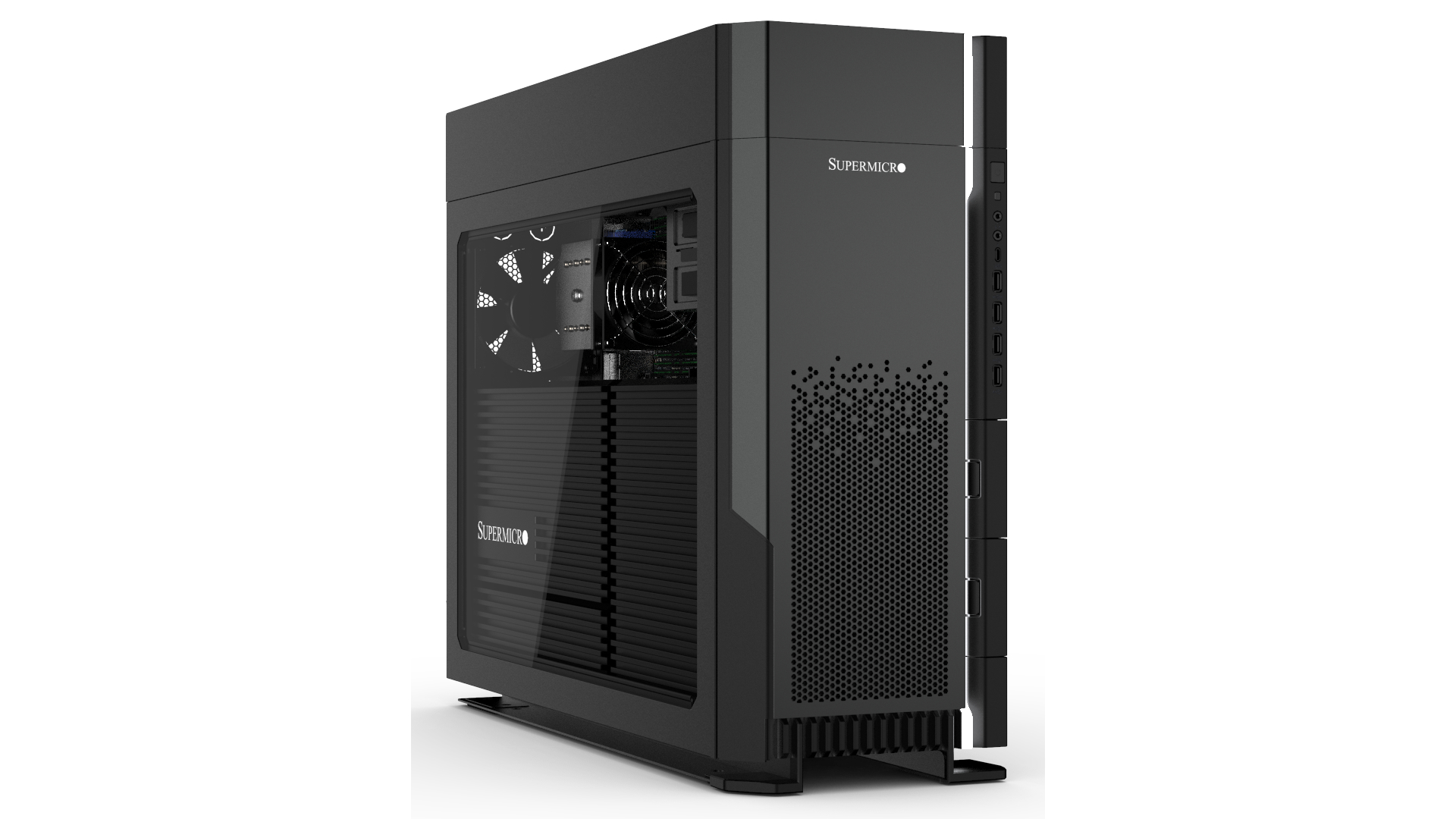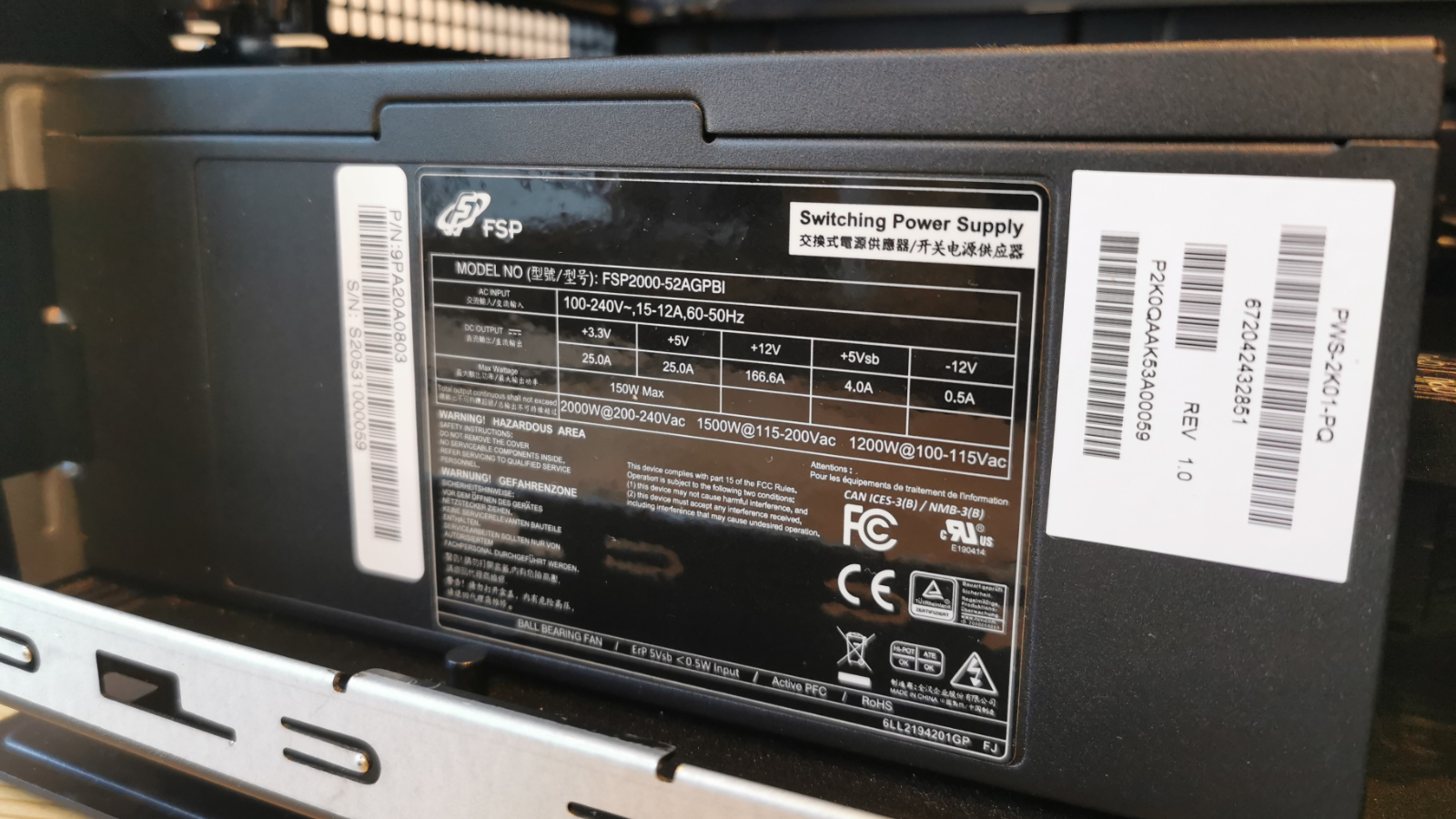Why you can trust TechRadar
In use
Everything about this computer is fast, and on occasion, a bit overwhelming.
But we’ll discuss just how quick it is later, so what is it like as a general computer?
Good, but there are a few wrinkles that any potential buyer might need to consider.
The Supermicro Super M12SWA-TF E-ATX motherboard has some great features, like more USB 3.2 Gen2 ports than we’ve ever seen before, and dual-LAN with 10GbE on one port and BMC/IPMI for remote monitoring and management.
It’s also one of the few boards we’ve seen with USB 3.2 Gen 2x2, allowing for 20Gbits of bandwidth on USB connected hardware.
However, where AMD dropped the ball on the WRX80 is that it doesn’t have Thunderbolt technology. For those that want local backups and extended storage, that feature would have been handy. It is possible to get roughly the same performance level out of the USB 3.2 Gen 2x2, but there are relatively few external storage devices that support that standard. Alternatively, 10GbE LAN can be used to connect a 10GbE NAS directly to the machine, but Thunderbolt would have been a more elegant option.
Unfortunately, this isn’t a feature you can add with a card, like hardware RAID.
Sign up to the TechRadar Pro newsletter to get all the top news, opinion, features and guidance your business needs to succeed!
Another mild weakness detected in our assessment was that this system came with two PCIe 3.0 M.2 drives installed, and the slots on this board support PCIe 4.0 modules.
We asked Boston about this, and they told us that when the system was constructed, no PCIe 4.0 drives had been certified for this board. That’s since changed, and current workstations can be specified with PCIe 4.0 drives.
Those that prefer water over the air cooling supplied in the review machine will also discover that Boston can supply that option.

Performance
Here's how the Supermicro AS-5014A-TT Workstation scored in our suite of benchmark tests:
Blender Bmw27 52s; Classroom 2m 21s; Fishy_cat 1m 10s; Koro 1m 54s; Pavilion_barcelona 2m 27s; Victor 4m 40s.
3DMark Wild Life Extreme: 31,171; Fire Strike: 24,744; Fire Strike Ultra: 9208; Time Spy: 10,450; Port Royal: 9665; DirectX Raytracing: 41.36 FPS
Cinebench R23 CPU: 1273 (single-core); 40,192 (multi-core)
GeekBench 5: 1,297 (single-core); 27,345 (multi-core), 180,325 (OpenCL)
CrystalDiskMark: Sequential Read: 3,307MB/s; Sequential Write: 3,052MB/s; PCMark 10: 7,273 points
PassMark: 8718.3 (99th Percentile).
CPU-Z: 511.2 (single thread); 20,545.8 (multi-thread)
Windows Experience Index: 9.1
It’s g-force inducingly fast. Shall we just leave it at that?
Where this machine differs from a typical high-performance PC is that most of the time, it keeps its true power relatively well hidden. When navigating the interface, opening applications or performing daily computing jobs, tasks are completed as briskly as you might expect.
The irony of those comments is that to breeze through most typical PC jobs, a very small percentage of the CPU or GPU power in this rig is required.
To better explore the true power under the surface, we deployed a few benchmarks that we don’t normally include designed to push these components to their limits.
The Blender benchmark suite can test CPU and GPU, isolated or in combination with its 3D rendering missions. Blender is exactly the sort of software that can use the power in this system, and the numbers here might be useful for those with an existing system that want to know how this Nvidia RTX A5000 and Threadripper 3975WX tag-team compares.
Another useful benchmark that we normally run is Cinebench R23, and here the number of cores and threads delivers amazing scores for multi-core performance.
The only chip that can go quicker is the 3995WX on multi-core testing, though the Intel i7-1165G7 is marginally faster at core operations. Achieving more than 40,000 points is impressive when you consider that the best Intel CPU at this task is the Xeon E5-2699 v4 (22 cores 44 threads), scoring just 32,600.
Those lucky enough to have an AMD Ryzen Threadripper Pro 3995WX (64 cores 128 threads) on this platform could easily see a score of 73,200.
We’ve included a good number of 3DMark tests, but with more CUDA cores, the retail RTX 3090 is faster than the A5000 in most of those tests. For a customer involved in game development, the retail RTX video cards are probably better suited. However, for CAD, simulations, and scientific processing, the A5000 is undoubtedly the better option.
In short, unless you are prepared to spend even more on the 3995WX and A6000, there isn’t much that is more powerful for running multi-threaded applications, especially those that exploit CUDA, DirectCompute or OpenCL.

Final verdict
Some might be reading this and wondering what role Boston Limited plays in this system, given that the platform is one built mainly by Supermicro for them.
Supermicro makes the AS-5014A-TT Workstation hardware, including the enclosure, motherboard, cooler, etc. You can purchase that equipment directly and source the other components elsewhere.
However, what Boston Limited offers is to source all the best parts to flesh this system out, assemble and test the platform, and if you want it, provide a support service that can get you up and running smartly, should the worst happen.
Some system builders can throw computers together based on the specific part deals they can get at a specific time, but Boston Limited is about delivering a balanced and reliable platform that the customer will enjoy and hopefully come back for more.
We should also mention that some parts, most notably the A5000 video card are almost impossible to get in retail at this time, so sourcing that one part might prove very challenging for those that aren’t already system builders.
The Supermicro AS-5014A-TT Workstation isn’t perfect, but it is as close to optimal as most workstation designs come. It might be big, heavy and occupies two IT people to move it around, but when you need extreme performance, it delivers.
It’s also got extensive expansion possibilities if the requirement is for multiple GPUs, fibre connected storage, or specialist development environments.
All this power and flexibility costs plenty, but you won’t get this authentic workstation experience spending less in this era of chip and GPU shortages.
- 1
- 2
Current page: In use, performance and verdict
Prev Page Introduction, price, design and hardwareMark is an expert on 3D printers, drones and phones. He also covers storage, including SSDs, NAS drives and portable hard drives. He started writing in 1986 and has contributed to MicroMart, PC Format, 3D World, among others.

